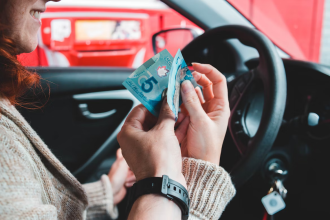Picture this: you’re driving through Los Angeles traffic on a sunny afternoon. Everything seems fine—until it isn’t. A distracted driver runs a red light and slams into your car. You’re injured. Your car is totaled. You assume your insurance has you covered.
- The Basics: What California Law Requires
- Standard Coverage Gaps Most Drivers Don’t Know About
- 1. Underinsured and Uninsured Motorist Coverage
- 2. Collision and Comprehensive Coverage
- 3. Medical Payments (MedPay) or Personal Injury Protection (PIP)
- 4. Rental Reimbursement
- 5. Gap Insurance for Leased or Financed Vehicles
- 6. Ride-Share and Delivery Driving Exclusions
- Why These Gaps Matter
- How to Protect Yourself
- California-Specific Risks to Consider
- Conclusion: Don’t Wait Until It’s Too Late
Then the bills start arriving. And you realize your policy has more holes than coverage.
This isn’t a rare story. Many California drivers carry only the minimum required coverage, and that’s the problem. Legal minimums are just that: minimum. They don’t protect you from the full cost of accidents, injuries, or unexpected claims.
In this article, we’ll explore the overlooked gaps in California auto insurance policies and what you can do to make sure you’re not left exposed when you need protection the most.
The Basics: What California Law Requires
California requires all drivers to carry a minimum amount of liability coverage. As of now, the minimums are:
- $15,000 for injury or death to one person
- $30,000 for injury or death to more than one person
- $5,000 for property damage
That might sound like enough. But it often isn’t.
Medical bills alone can exceed $15,000 in a matter of hours. If you total someone else’s vehicle—or worse, injure multiple people—you could be responsible for tens or even hundreds of thousands of dollars beyond what your policy pays.
Here’s the reality: Minimum coverage meets legal requirements. It doesn’t mean you’re financially protected.
Standard Coverage Gaps Most Drivers Don’t Know About
Let’s walk through the most critical gaps that standard policies often ignore.
1. Underinsured and Uninsured Motorist Coverage
This is the most overlooked protection, despite California having one of the highest rates of uninsured drivers in the country.
If someone hits you and doesn’t have insurance—or has too little—you’re left to pick up the tab unless you have uninsured/underinsured motorist coverage.
Without it, your recovery may depend entirely on suing someone who has no money to begin with.
2. Collision and Comprehensive Coverage
Liability insurance only covers other people’s damages. If your car is wrecked, stolen, or damaged in a fire, standard liability won’t help you.
That’s where collision (covers crashes) and comprehensive (covers non-crash events like theft, vandalism, and natural disasters) come in.
If your car is newer or worth more than a few thousand dollars, skipping this coverage is a gamble you probably can’t afford.
3. Medical Payments (MedPay) or Personal Injury Protection (PIP)
Do you think your health insurance will handle injuries after a crash? Maybe. Maybe not.
MedPay or PIP fills in the gaps, covering expenses such as ambulance fees, dental injuries, and even funeral costs. These policies can also help cover lost wages while you recover, which standard health insurance usually does not.
4. Rental Reimbursement
After an accident, your car might be in the shop for weeks. Will your insurance cover a rental car during that time?
Most base policies won’t. Rental reimbursement coverage ensures you’re not left without transportation or forced to pay hundreds out of pocket for a vehicle while yours is being repaired.
5. Gap Insurance for Leased or Financed Vehicles
Cars depreciate quickly. If your leased or financed car is totaled, your insurance may only pay its market value, not what you still owe on the loan.
That gap can be thousands of dollars. Gap insurance closes it, protecting you from debt even after your vehicle is gone.
6. Ride-Share and Delivery Driving Exclusions
Driving for Uber, Lyft, or DoorDash? Your policy likely won’t cover you while the app is on.
Most insurers exclude commercial use. To be covered, you’ll need a ride-share endorsement or commercial policy. If you don’t have one and get into an accident, you’re likely on your own financially.
Understanding these exclusions is key to getting the most out of your California car insurance not just meeting state requirements, but truly protecting yourself in real-world scenarios.
Why These Gaps Matter
These gaps aren’t just technicalities. They translate into real consequences:
- Unexpected out-of-pocket costs
- Denied claims
- Legal exposure
- Lost wages
- Stress and disruption
Accidents are traumatic enough. Fighting your insurer—or facing financial ruin—makes it worse. Being underinsured can turn a bad day into a long-term burden.
How to Protect Yourself
It’s not just about having insurance. It’s about having the right insurance.
Here’s what to do:
- Review your policy in detail. Don’t assume anything. Know exactly what’s covered and what isn’t.
- Ask direct questions. Call your agent and say: “If my car is totaled tomorrow, what will I owe?” or “What if someone hits me and they’re uninsured?”
- Consider add-ons. Coverage options like MedPay, rental reimbursement, and uninsured motorist protection typically cost only a few extra dollars per month.
- Compare multiple providers. The cheapest quote isn’t always the best. Look for value, not just price.
- Bundle with other policies. Discounts are often available when you combine auto insurance with homeowners’ or renters’ insurance.
California-Specific Risks to Consider
Living in California comes with unique challenges, and your policy should reflect them.
- Wildfires and earthquakes are genuine threats. While earthquakes are typically not covered by auto insurance policies, fires may be covered under comprehensive coverage. Confirm it.
- Flash floods and mudslides are increasingly common. Again, you’ll need comprehensive coverage.
- High-density traffic zones, such as those in San Francisco and Los Angeles, carry an increased risk of accidents. That alone justifies higher liability and uninsured motorist limits.
Conclusion: Don’t Wait Until It’s Too Late
Auto insurance isn’t just a box to check. It’s a safeguard for your health, your finances, and your future.
If you haven’t read your policy lately—or ever—now is the time. Find the gaps. Ask the hard questions. Make the updates.
Because when the unexpected happens, “I thought I was covered” won’t stop the bills from coming.












![branding-predictions-for-2020-[article]](https://thenewsgod.com/wp-content/uploads/2019/12/11260/branding-predictions-for-2020-article-330x220.jpg)
